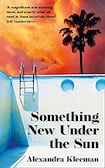
In an RTÉ documentary earlier this year, Colm Tóibín: On Memory's Shore, the Wexford author spoke about the successful film adaptation of his Booker-nominated novel Brooklyn. He told a funny and self-deprecating anecdote about his less than illustrious pass to the Oscars, which saw him seated towards the back, as the mere author of the source material. That same year at the awards, Emma Donoghue was further up the front as both the author and a credited screenwriter of Room.
The way in which Hollywood treats authors makes for some great satirical scenes in Alexandra Kleeman’s second novel, Something New Under the Sun. When the New York novelist Patrick Hamlin arrives in LA to work on a film adaptation of his autobiographical novel Elsinore Lane, he proudly announces to a group of production assistants that he’s the writer. “Screenwriter?” responds Dillon, one of the PAs, quickly bursting a bubble that had little chance of lasting anyway in the parched, decaying landscape of Kleeman’s near-future California.
A takedown of the greed and superficiality of the film industry is only one strand of this multifaceted book. Something New Under the Sun is a wide-ranging, ambitious novel that has plenty to say about the current state of the world. Mixing styles in a way that is inventive and deliberately disconcerting, the book is more focused on ideas than plot. As with many eco-parables, the end is largely and tragically predetermined. The story is more about how we got here. Along the way, Kleeman takes on capitalism, corruption and environmental disaster in a book that is part eco-horror story, part Californian noir.
The thriller aspect sees Patrick team up with the film’s troubled starlet Cassidy Carter to investigate why the movie production has stalled. Wealthy producers Jay and Brenda seem more interested in making money than making pictures. This storyline is linked to a dystopian subplot about WAT-R, the water substitute that most Californians drink, unless they’re part of an uber-rich elite. The plot gets more convoluted as time goes on: faceless corporate structures that all look identical (shades of the Amazon Prime series Homecoming), dementia-riddled patients, roads that go nowhere, and a mysterious man in a grey suit who appears to be a kind of 21st-centruy grim reaper, smooth, slick and scythe-less.
Finetuning
At times it can all feel a bit much, though Kleeman is skilled at finetuning details to give a convincing picture of the apocalypse. In this, her book recalls two standout examples of near-future dystopias from last year – Rumaan Alam’s Leave the World Behind and Diane Cook’s Booker-shortlisted The New Wilderness. Both of these offered compelling accounts of the horrific losses that might be just around the corner. Kleeman does likewise as she documents the lack of natural resources for ordinary Americans and the scorched landscape of California as it moves inevitably towards unstoppable fires. As temperatures in the northwest of America and Canada hit record highs (again) this summer, there is a scarily fine line here between fiction and reality, the near-future and now.
Kleeman is a Staten Island-based writer of fiction and nonfiction, and the winner of the 2016 Bard Fiction Prize. Her fiction has been published in the New Yorker, the Paris Review, Zoetrope: All-Story, Conjunctions, and Guernica, among others. Her debut novel, You Too Can Have A Body Like Mine, was longlisted for the Gordon Burn Prize and the John Leonard Prize.
The tone of her new novel is as acerbic as her debut. There is the sense that little gets past this author. Whether the observations are real-world – “waitstaff and hostess, staring into the bottomless depths of their smartphones” – or metafictional – “Patrick hated the convention of flashback and backstory as a way to pretend that characters were deeper and richer than they appeared to be in the moment” – they are delivered in the same stylishly cutting manner.
Consumption
Thematically there are also similarities – a society obsessed with consumption and in exploiting the female body for commercial gain. Cassidy’s history as a child star makes for moving and interesting fiction. The same is true of a subplot that sees Patrick’s wife and daughter relocate to an eco-commune to mourn the loss of the natural world. These perspectives are all vividly different, showing Kleeman’s range with voice. They add depth and offer relief from the sci-fi narrative, which grows tiresome at times, as Patrick trawls fan forums and watches old episodes of Cassidy’s TV series Kassi Keene.
Wholly believable
The strength of this novel is in the stark way that Kleeman sets out a wholly believable near-future apocalypse. Forget those sunny west-coast vibes, California dreaming this is not: “She’s woken up to find lame geese resting, head under wing, in an inch of standing water, remnant of last week’s anaemic rain, and baby squirrels trapped and dehydrated, concealing their small bodies under a scattering of dead leaf matter.”













